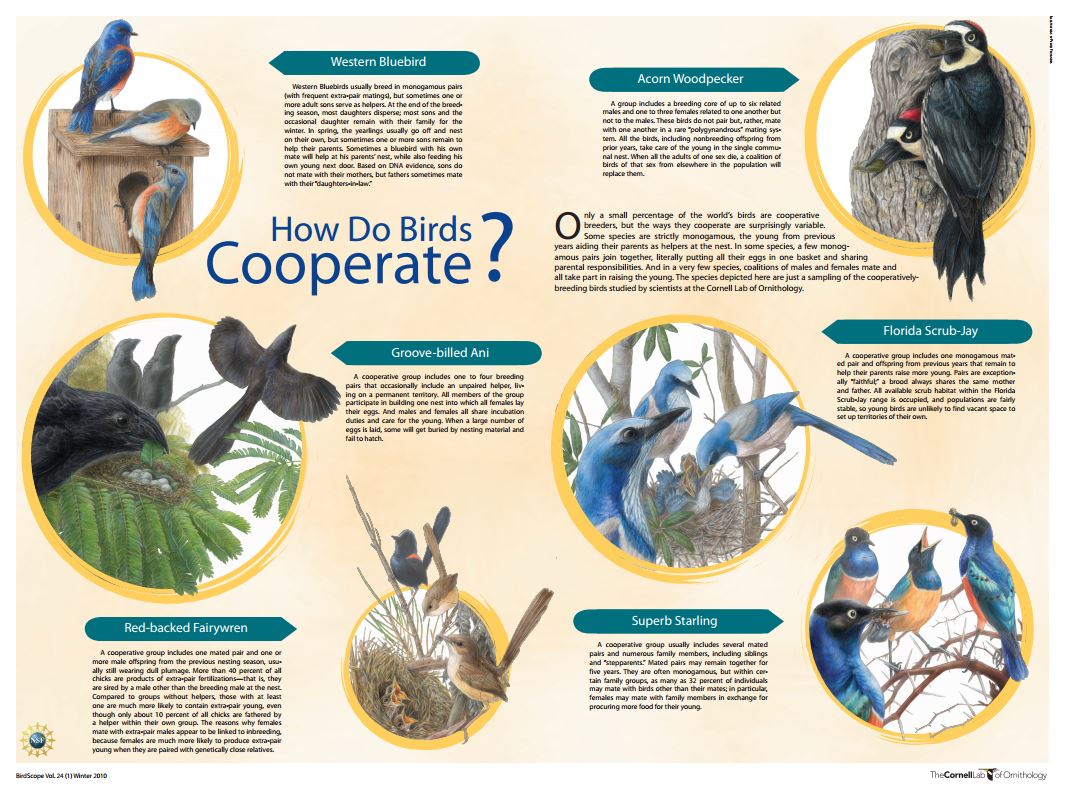How Do Birds Cooperate? An Overview of Strategies
Illustrations by Pedro Fernandes
January 15, 2010

Only a small percentage of the world’s birds are cooperative breeders, but the ways they cooperate are surprisingly variable. Some species are strictly monogamous, the young from previous years aiding their parents as helpers at the nest. In some species, a few monogamous pairs join together, literally putting all their eggs in one basket and sharing parental responsibilities. And in a very few species, coalitions of males and females mate and all take part in raising the young. The species depicted here are just a sampling of the cooperatively- breeding birds studied by scientists at the Cornell Lab of Ornithology.


Western Bluebird
Western Bluebirds usually breed in monogamous pairs (with frequent extra-pair matings), but sometimes one or more adult sons serve as helpers. At the end of the breeding season, most daughters disperse; most sons and the occasional daughter remain with their family for the winter. In spring, the yearlings usually go off and nest on their own, but sometimes one or more sons remain to help their parents. Sometimes a bluebird with his own mate will help at his parents’ nest, while also feeding his own young next door. Based on DNA evidence, sons do not mate with their mothers, but fathers sometimes mate with their “daughters-in-law.”


Groove-billed Ani
A cooperative group includes one to four breeding pairs that occasionally include an unpaired helper, living on a permanent territory. All members of the group participate in building one nest into which all females lay their eggs. And males and females all share incubation duties and care for the young. When a large number of eggs is laid, some will get buried by nesting material and fail to hatch.


Red-backed Fairywren
A cooperative group includes one mated pair and one or more male offspring from the previous nesting season, usually still wearing dull plumage. More than 40 percent of all chicks are products of extra-pair fertilizations—that is, they are sired by a male other than the breeding male at the nest. Compared to groups without helpers, those with at least one are much more likely to contain extra-pair young, even though only about 10 percent of all chicks are fathered by a helper within their own group. The reasons why females mate with extra-pair males appear to be linked to inbreeding, because females are much more likely to produce extra-pair young when they are paired with genetically close relatives.


Acorn Woodpecker
A group includes a breeding core of up to six related males and one to three females related to one another but not to the males. These birds do not pair but, rather, mate with one another in a rare “polygynandrous” mating system. All the birds, including nonbreeding offspring from prior years, take care of the young in the single communal nest. When all the adults of one sex die, a coalition of birds of that sex from elsewhere in the population will replace them.


Florida Scrub-Jay
A cooperative group includes one monogamous mated pair and offspring from previous years that remain to help their parents raise more young. Pairs are exceptionally “faithful;” a brood always shares the same mother and father. All available scrub habitat within the Florida Scrub-Jay range is occupied, and populations are fairly stable, so young birds are unlikely to find vacant space to set up territories of their own.
Superb Starling
A cooperative group usually includes several mated pairs and numerous family members, including siblings and “stepparents.” Mated pairs may remain together for five years. They are often monogamous, but within certain family groups, as many as 32 percent of individuals may mate with birds other than their mates; in particular, females may mate with family members in exchange for procuring more food for their young.
Originally published in the January 2010 issue of BirdScope.


All About Birds is a free resource
Available for everyone,
funded by donors like you


